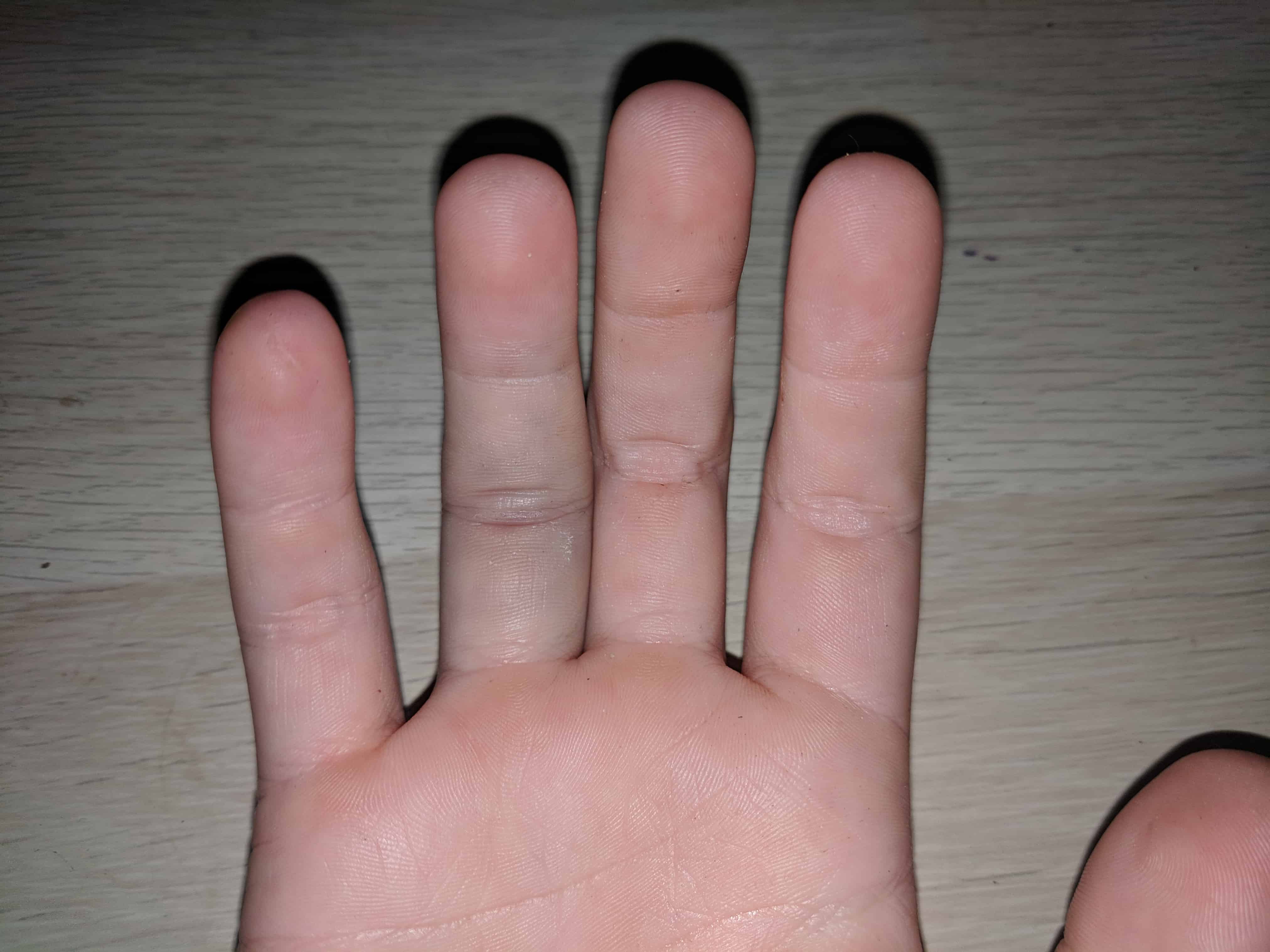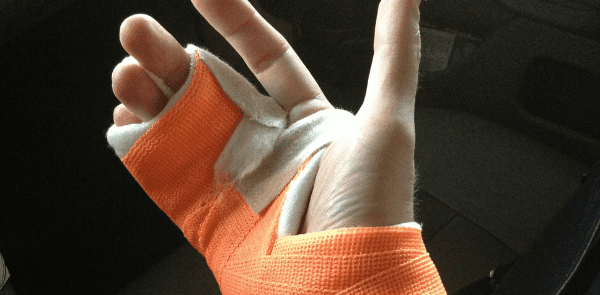A finger sprain is a common injury to the hand. It can be uncomfortable, but it should heal in no time after medical treatment.
Sprains occur in any joint of the body, and among the most target spots are the fingers. They’re at higher risk of injury from falls and trauma, besides the thumb and the knee.
Although common in most athletes, anyone can overstretch their fingers and cause sprains. The case is different from a finger dislocation, though, but it can have similar symptoms.
To help you understand, here’s an overview of what a finger sprain is. The causes and symptoms and treatments available are included.
Sprained Finger
 (Image Credit: Wikimedia Commons)
(Image Credit: Wikimedia Commons)
A physical impact to the finger, such as a blow to the end, is the number one cause of a jammed finger. This involves torn or stretched tissues, causing ligament damage in the digits.
This soft tissue, called a ligament, is what connects the joints. In your hand, there are two collateral ligaments – one on each side of the joint, providing stability. Moreover, they keep your fingers in proper alignment.
Hyperextending any of them can lead to soft tissue injury — cue a sprained finger. Such sprains can be in any of the knuckle finger joints. But the joint in the middle is the most aimed part, and it’s called the proximal interphalangeal joint (PIP).
Causes
Sprains can happen anytime a finger bends in an abnormal position. As mentioned, they are caused by a blow to the end of a finger. This reverberates up to the joint, causing it to overstretch the ligaments.
Falling on your hand or an impact from playing contact sports can result in injuries. Sports injuries are another determinant, especially in basketball, football and volleyball. For instance, if the player misses the ball with the tips of their fingers, a sprain may occur.
If you have weak ligaments, poor balance or coordination problems, sprains are likely. Accidents and any work-related injury may also lead to spraining the finger.
Symptoms
Inflammation is the primary symptom of this type of hand injury. Reduced mobility of the injured finger may also be plausible, including:
- Bruising
- Pain
- Redness
- Swelling
- Tenderness
There are three different grades of finger sprains – each has its own symptoms. Your urgent care specialist may assign a grade based on the severity of your sprain, and these are:
First-degree sprain
A first-degree sprain involves stretched but not torn ligaments. It’s the mildest among the three. The strength and stability of the finger and joint aren’t affected, but symptoms may include:
- Localised pain and swelling around the joint
- Limited range of motion (e.g. flexing or extending the finger)
Second-degree sprain
At this degree, more damage is done to the ligament, causing moderate sprains. This may also affect the joint capsule and include a partial tear of the tissue. Symptoms may include:
- Intense pain
- Significant swelling, which may extend to the full finger
- Limited range of movement (may also affect the entire finger)
- Mild instability of a joint
Third-degree sprain
The most severe type of sprain. It indicates severe tearing or complete rupture of the ligament. Expected symptoms are the following:
- Discolouration of the finger
- Full or partial dislocation of the injured finger
- Severe pain and swelling
- Instability of the full finger
If you sprain your finger, seek medical advice at once. If left untreated, it could get worse.
Diagnosis
For a first-degree sprain, home treatments can help. But if there’s no improvement after 3-4 days, make an appointment and talk to your health care provider. Second- and third-degree sprains, however, need medical treatment as soon as possible.
To diagnose, the doctor will take a physical exam and ask about the symptoms. The process may involve extending and flexing your finger to see how well it moves. Imaging tests, such as an X-ray, may also be ordered to rule out a possible fracture and the extent of the damage. The latter is a common case for suspected third-degree sprains.
Treatments
To treat a sprained finger at home, RICE therapy can help reduce blood flow and inflammation.
- Rest. Let the affected finger rest by limiting the use for a few days after the initial phase of injury.
- Ice. Apply an ice pack or compress wrapped in a cloth to the injured area for 15 to 20 minutes at a time. Take a 20-minute break between icing sessions and repeat hourly a day. Note: Don’t expose the skin directly to the ice. If the finger becomes more painful, swollen, or darker in colour, stop using the ice.
- Compression. Wrap the finger with sports or medical tape or an elastic bandage. Tight the bandage enough to apply light pressure to the finger – also, ensure it’s comfortable. Remove after the first 24 to 48 hours or when inflammation has reduced – then, buddy tape.
- Elevation. Keep the finger elevated (e.g. raised at level above the heart). This will help minimise swelling, especially within the first 24 – 72 hours. You may use a sling to keep it raised while standing, walking, or even sleeping.
Over-the-counter pain medications can also aid the symptoms for the first few days.
Note: To buddy tape, bind the injured finger to a healthy finger next to it. This method helps protect it from further injury and encourages faster healing.
Finger exercises
Once the pain and swelling have decreased, mobility exercises help restore full movement. Performing a range of motion exercises also helps encourage healthy blood flow. Plus, it prevents muscle loss to the finger.
Hand-strengthening routines with putty or an exercise ball are effective. Avoid exercises that increase pain or make you feel very uncomfortable.
Surgery
For third-degree sprains, where the ligament is severely torn, surgery may be necessary. This process will help repair the tissue and allow it to heal properly. Otherwise, an unstable joint is a possibility.
After surgery, the doctor will put a splint or cast on the finger, which you’ll need to keep for several weeks. Buddy taping is also best during the final weeks of healing after the splint/cast has been removed.
Splint/finger braces
Moderate sprains often benefit from the use of a splint or finger brace. Either of the two ensures ligament restriction while it heals. After removing the splint, you may buddy tape the finger until it completely heals.
Recovery
 (Image Credit: Wikimedia Commons)
(Image Credit: Wikimedia Commons)
Recovery time depends on the extent of the injury. But with basic rest and care, most sprained fingers start to feel better within 48 hours. Moderate sprains often take 3 to 6 weeks to heal, while severe ones take two to three times longer, tops.
Prevention
Finger sprains can be painful, but lucky for you, they’re treatable and preventable. Stretching before exercising and building muscle strength are great habits for prevention. Wearing protective gear when engaging in any sport or physical activity also helps.
To find out how badly you’ve hurt your finger, you’ll need to see a doctor. Seek medical attention if symptoms don’t improve within 24 to 48 hours. These could be signs of a more severe injury, such as a broken finger.


